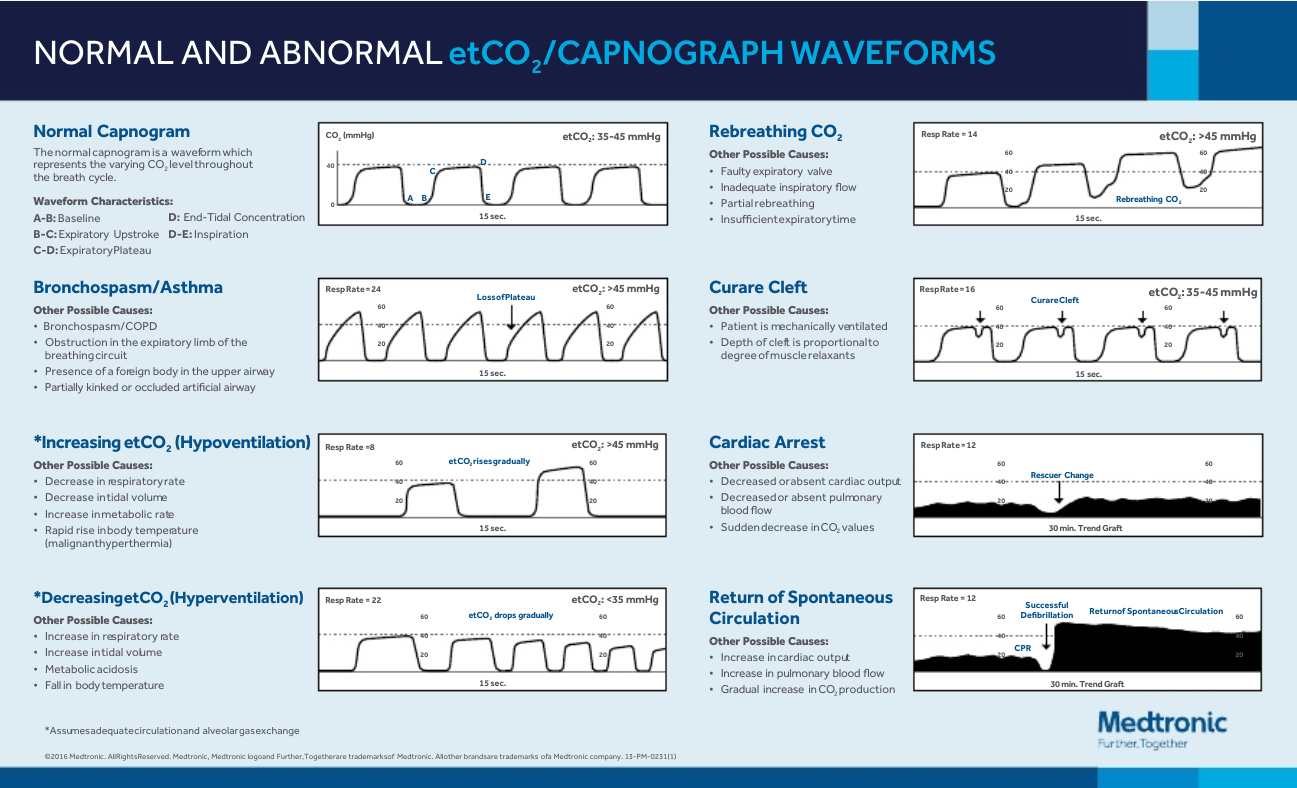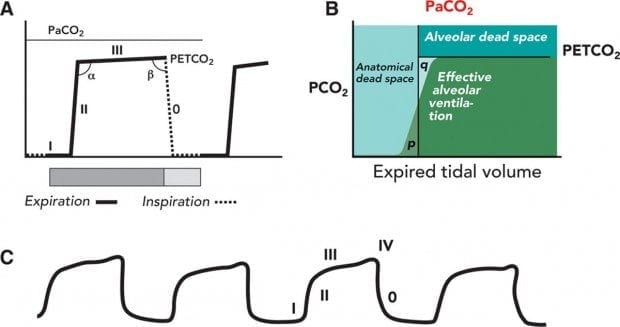end tidal co2 meaning
End-tidal capnography or end-tidal CO2 EtCO2 monitoring is a non-invasive technique that measures the partial pressure or maximal concentration of carbon dioxide CO2 at the end of an exhaled breath. End-tidal carbon dioxide ETco 2 monitoring provides valuable information about CO 2 production and clearance ventilation.
5 Medical Conditions Where Capnography Can Affect Bls Care Capnoacademy Capnoacademy
This non-invasive monitor can give valuable information about cardiac output perfusion and ventilation.

. End-tidal carbon dioxide monitoring is a noninvasive method of measuring exhaled carbon dioxide. We routinely use ETCO2 to provide information on ventilation. Carbon dioxide through the respiratory cycle Measuring of End tidal CO2 is considered a standard of care for confirming endotracheal tube placement An important adjunct for assessing a critical patient The Journey of A Molecule Through the Respiratory Cycle.
Eisenberg and Terry J. Savastano S et al. End-tidal carbon dioxide ETCO2 is the level of carbon dioxide that is released at the end of an exhaled breath.
Medical Definition of end-tidal. MONITORING of end-tidal carbon dioxide is one of the most important means of determining the physiologic well-being of anesthetized patients. But ETCO2 can also provide valuable information on the adequacy of cardiac perfusion.
ETCO2 levels reflect the adequacy with which carbon dioxide CO2 is carried in the blood back to the lungs and exhaled. End-tidal CO 2 monitoring has also been useful for breathing retraining as it provides additional information about the progress of a persons breathing normalization. End-tidal CO2 EtCO2 monitoring is a noninvasive technique which measures the partial pressure or maximal concentration of carbon dioxide CO2 at the end of an exhaled breath which is expressed as a percentage of CO2 or mmHg.
Like pulse oximetry before it alerting us to changes in oxygenation end-tidal CO2 monitoring or ETCO2 is rapidly becoming an additional vital sign. It is the measurement of CO2 at the completion of exhalation and roughly correlates to the CO2 present in arterial blood. This technique is often used in patients who are not intubated although it is commonly used in intubated patients receiving mechanical ventilation.
The arterial CO2 value for normal breathing at rest is 40 mm. Most medical sources define hypocapnia as less than 35 mm Hg for partial CO2 pressure in the arterial blood. Monitoring end-tidal CO 2 ET-CO 2 provides instantaneous information about ventilation how effectively CO 2 gas is being exhaledeliminated by the respiratory system perfusion how effectively CO 2 is being transported through the vascular system to the lungs and metabolism how effectively CO 2 is being produced by cellular metabolism.
In normal conditions CO2 is 5 to 6 which is equivalent to 35-45 mmHg. End-tidal carbon dioxide EtCO 2 waveform monitoring allows you to measure all three. Carbon dioxide CO 2 is a product of metabolism transported via perfusion and expelled through ventilation.
Exhaled carbon dioxide both in terms of its quantity and pattern provides detailed information on the cardiopulmonary system. End-tidal carbon dioxide monitoring ETCO2 has clinical uses far beyond solely determining hypo- or hyperventilation. This is a major respiratory symptom.
Definition of Low CO2 hypocapnia Hypocapnia hypocapnea also known as hypocarbia is defined as a deficiency of carbon dioxide in the arterial blood. ETCO2 levels reflect the adequacy with which carbon dioxide CO2 is carried in the blood back to the lungs and exhaled. Sometimes however etCO 2 monitoring is used as a feedback or biofeedback mechanism.
Capnograph is an indispensable tool for monitoring metabolic and respiratory function. In fact its commonly called the ventilation vital sign. In critical care End Tidal CO 2 monitoring is used to assess adequacy of circulation to the lungs which provides clues about circulation to the rest of the body.
End-tidal carbon dioxide ETCO2 is the level of carbon dioxide that is released at the end of an exhaled breath. Monitoring of end-tidal carbon dioxide EtCO2 is a noninvasive method that measures the partial pressure or maximal concentration of carbon dioxide CO2 at the end of exhaled breath which is expressed as a percentage of CO2. In this study the aim was to review the applications of end-tidal carbon dioxide ETCO2 monitoring in emergency department multiple databases were comprehensively searched with combination of following keywords.
End tidal carbon dioxide concentration. The normal values are 5 to 6 CO2 which is equivalent to 35-45 mmHg. When the spontaneous breathing of the patients started their respirations were supported as the end-tidal carbon dioxide ETC Osub2 value would be 35-40 mmHg.
End-tidal CO2 EtCO2 monitoring is a noninvasive technique which measures the partial pressure or maximal concentration of carbon dioxide CO2 at the end of an exhaled breath which is expressed as a percentage of CO2 or mmHg. The normal values are 5 to 6 CO2 which is equivalent to 35-45 mmHg. Of or relating to the last portion of expired tidal air End-tidal carbon dioxide monitors are already being used and are recommended to indicate the adequacy of cardiopulmonary resuscitation and the likelihood of a successful resuscitation.
Can the value of end tidal CO2 prognosticate ROSC in patients coding into emergency department with an out-of-hospital cardiac arrest. Also called capnometry or capnography this noninvasive technique provides a breath-by-breath analysis and a continuous recording of ventilatory status. Low EtCO 2 with other signs of shock indicates poor systemic perfusion which can be caused by hypovolemia sepsis or dysrhythmias.
End-tidal carbon dioxide and defibrillation success in out-of-hospital cardiac arrest. Mengert The New England Journal of Medicine. ETCO2 emergency department monitoring and critical.

Waveform Capnography In The Intubated Patient Emcrit Project
Riding The Wave Of Capnography Understanding Etco2 Vetbloom Blog

Etco2 Valuable Vital Sign To Assess Perfusion The Airway Jedi

Basic Capnography Interpretation Nuem Blog
End Tidal Co2 The Drummer Of The Vital Sign Band Pem4

Normal And Abnormal Capnography Waveforms Infographic Capnoacademy Capnoacademy

End Tidal Co2 Monitoring In The Pre Hospital Environment More Than Just Endotracheal Tube Placement Confirmation Journal Of Paramedic Practice

Capnography Waveform Interpretation Litfl Ccc Equipment

Waveform Capnography In The Intubated Patient Emcrit Project
Riding The Wave Of Capnography Understanding Etco2 Vetbloom Blog

The Impact Of Ventilation Rate On End Tidal Carbon Dioxide Level During Manual Cardiopulmonary Resuscitation Resuscitation

Waveform Capnography In The Intubated Patient Emcrit Project
Emdocs Net Emergency Medicine Educationcapnography In The Ed Emdocs Net Emergency Medicine Education

Basic Capnography Interpretation Nuem Blog

Quantitative Waveform Capnography Acls Medical Training

Waveform Capnography In The Intubated Patient Emcrit Project
